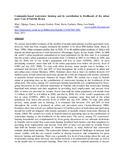| dc.description.abstract | No current and reliable estimates of the number of people participating in urban agriculture exist; however, Smit and Nasr roughly estimated the number to be about 800 million (Smit, Ratta, & Nasr, 1996). Other estimates predict that in 2020, 35 to 40 million urban residents of Africa will depend on urban agriculture to feed themselves (Denninger,
Egero, & Lee-Smith, 1998). In 2008 the world’s urban population outnumbered its rural population for the first time. It is estimated that the world’s urban population will double from 3.3 billion in 2007 to 6.4 billion in 2050, and that by 2030, 6% of the world’s population will live in cities (UNFPA, 2007). In most developing countries, more than
half of the urban population lives below the poverty level of USD1 per day (UN, 2008). To
cope with urban poverty, many people turn to farming; it is estimated that between 15% and 20% of food throughout the world is produced in urban and peri-urban areas (Armar-Klemesu, 2000). Estimates show that at least two million hectares (4.9 million acres) in both urban and rural areas around the world are irrigated with treated, untreated, or partially treated wastewater (Jimenez & Asano, 2004). We carried out a study in Nairobi
aimed at generating data on the contributions of wastewater farming to the livelihoods of the urban poor. The survey among 232 wastewater-farming households was complemented by focus-group discussions in two informal settlements in Nairobi,
and revealed that wastewater farming benefited both farmers and their neighbors by providing food, employment, and income. Over 60% of labor was provided by women. Fewer than half the urban population will double from 3.3 billion in 2007 to 6.4 billion in 2050, and that by 2030, 6% of the world’s population will live in cities (UNFPA, 2007). In most developing countries, more than half of the urban population lives below the
poverty level of USD1 per day (UN, 2008). To cope with urban poverty, many people turn to farming; it is estimated that between 15% and 20% of food throughout the world is produced in urban and peri-urban areas (Armar-Klemesu, 2000). Estimates show that at least two million hectares (4.9 million acres) in both urban and rural areas around the world are irrigated with treated, untreated, or partially treated wastewater (Jimenez
& Asano, 2004). We carried out a study in Nairobi aimed at generating data on the contributions of wastewater farming to the livelihoods of the urban poor. The survey among 232 wastewater-farming households was complemented by focus-group
discussions in two informal settlements in Nairobi, and revealed that wastewater farming benefited both farmers and their neighbors by providing food, employment, and income. Over 60% of labor was provided by women. Fewer than half the farmers used manure or chemical fertilizer, as many believed that wastewater contains plant-based nutrients. The wastewater farmers experienced challenges in insecure land tenure, conflict with the
city council, conflict in sharing resources, and competition for space between farming and housing. There was a generally low level of knowledge about the safe use of pesticides among those surveyed, and further research is recommended on this topic as well as on the health risks of wastewater farming. There also is a need to establish platforms
to discuss and resolve resource-use conflicts in wastewater farming, as well as on issues related to incorporating urban agriculture into urban land use.
Keywords: Wastewater farming, urban agriculture, informal settlements, Kenya | en |

